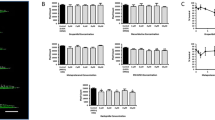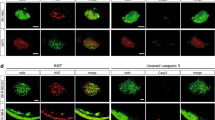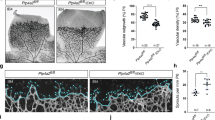Abstract
Angiogenesis is essential for development and tumor progression. With the aim of identifying new compound inhibitors of the angiogenesis process, we used an established enhanced green fluorescent protein-transgenic zebrafish line to develop an automated assay that enables high-throughput screening of compound libraries in a whole-organism setting. Using this system, we have identified novel kinase inhibitor compounds that show anti-angiogenic properties in both zebrafish in-vivo system and in human endothelial cell in-vitro angiogenesis models. Furthermore, we have determined the kinase target of these compounds and have identified and validated a previously uncharacterized involvement of phosphorylase kinase subunit G1 (PhKG1) in angiogenesis in vivo. In addition, we have found that PhKG1 is upregulated in human tumor samples and that aberrations in gene copy number of PhK subunits are a common feature of human tumors. Our results provide a novel insight into the angiogenesis process, as well as identify new potential targets for anti-angiogenic therapies.
This is a preview of subscription content, access via your institution
Access options
Subscribe to this journal
Receive 50 print issues and online access
$259.00 per year
only $5.18 per issue
Buy this article
- Purchase on Springer Link
- Instant access to full article PDF
Prices may be subject to local taxes which are calculated during checkout







Similar content being viewed by others
References
Berghmans S, Murphey RD, Wienholds E, Neuberg D, Kutok JL, Fletcher CD et al. (2005). tp53 mutant zebrafish develop malignant peripheral nerve sheath tumors. Proc Natl Acad Sci USA 102: 407–412.
Carman MD, Schornagel JH, Rivest RS, Srimatkandada S, Portlock CS, Duffy T et al. (1984). Resistance to methotrexate due to gene amplification in a patient with acute leukemia. J Clin Oncol 2: 16–20.
Carmeliet P, Jain RK . (2000). Angiogenesis in cancer and other diseases. Nature 407: 249–257.
Cascante M, Benito A, Zanuy M, Vizan P, Marin S, de Atauri P . (2010). Metabolic network adaptations in cancer as targets for novel therapies. Biochem Soc Trans 38: 1302–1306.
Edmunds SC, Kelsell DP, Hungerford JL, Cree IA . (2002). Mutational analysis of selected genes in the TGFbeta, Wnt, pRb, and p53 pathways in primary uveal melanoma. Invest Ophthal Vis Sci 43: 2845–2851.
Eilken HM, Adams RH . (2010). Dynamics of endothelial cell behavior in sprouting angiogenesis. Curr opin cell biol 22: 617–625.
Faucherre A, Taylor GS, Overvoorde J, Dixon JE, Hertog J . (2008). Zebrafish pten genes have overlapping and non-redundant functions in tumorigenesis and embryonic development. Oncogene 27: 1079–1086.
Ferguson PJ . (1991). The role of gene amplification in clinical resistance to chemotherapy: a review. J Otolaryngol 20: 130–136.
Folkman J . (2007). Angiogenesis: an organizing principle for drug discovery? Nat Rev 6: 273–286.
Goker E, Waltham M, Kheradpour A, Trippett T, Mazumdar M, Elisseyeff Y et al. (1995). Amplification of the dihydrofolate reductase gene is a mechanism of acquired resistance to methotrexate in patients with acute lymphoblastic leukemia and is correlated with p53 gene mutations. Blood 86: 677–684.
Gorre ME, Mohammed M, Ellwood K, Hsu N, Paquette R, Rao PN et al. (2001). Clinical resistance to STI-571 cancer therapy caused by BCR-ABL gene mutation or amplification. Science 293: 876–880.
Gragoudas ES, Adamis AP, Cunningham Jr ET, Feinsod M, Guyer DR . (2004). Pegaptanib for neovascular age-related macular degeneration. New Engl J Med 351: 2805–2816.
Graves D, Bartleson C, Biorn A, Pete M . (1999). Substrate and inhibitor recognition of protein kinases: what is known about the catalytic subunit of phosphorylase kinase? Pharmacol Ther 82: 143–155.
Hurwitz H, Fehrenbacher L, Novotny W, Cartwright T, Hainsworth J, Heim W et al. (2004). Bevacizumab plus irinotecan, fluorouracil, and leucovorin for metastatic colorectal cancer. New Engl J Med 350: 2335–2342.
Isogai S, Horiguchi M, Weinstein BM . (2001). The vascular anatomy of the developing zebrafish: an atlas of embryonic and early larval development. Dev Biol 230: 278–301.
Kidd KR, Weinstein BM . (2003). Fishing for novel angiogenic therapies. Brit J Pharmacol 140: 585–594.
Kroemer G, Pouyssegur J . (2008). Tumor cell metabolism: cancer's Achilles’ heel. Cancer Cell 13: 472–482.
Lane DP, Cheok CF, Lain S . (2010). p53-based cancer therapy. Cold Spring Harb Perspect Biol 2: a001222.
Lawson ND, Weinstein BM . (2002). In vivo imaging of embryonic vascular development using transgenic zebrafish. Dev Biol 248: 307–318.
Letamendia A, Quevedo C, Ibarbia I, Virto JM, Holgado O, Diez M et al. Development and validation of an automated high-throughput system for zebrafish in vivo screenings. Plos One (submitted).
Liang D, Chang JR, Chin AJ, Smith A, Kelly C, Weinberg ES et al. (2001). The role of vascular endothelial growth factor (VEGF) in vasculogenesis, angiogenesis, and hematopoiesis in zebrafish development. Mech Dev 108: 29–43.
Lyons MS, Bell B, Stainier D, Peters KG . (1998). Isolation of the zebrafish homologues for the tie-1 and tie-2 endothelium-specific receptor tyrosine kinases. Dev Dyn 212: 133–140.
Marshall KE, Tomasini AJ, Makky K, Kumar SN, Mayer AN . (2011). Dynamic Lkb1-TORC1 signaling as a possible mechanism for regulating the endoderm-intestine transition. Dev Dyn 239: 3000–3012.
Parng C, Seng WL, Semino C, McGrath P . (2002). Zebrafish: a preclinical model for drug screening. Assay Drug Dev Technol 1: 41–48.
Pownall ME, Tucker AS, Slack JM, Isaacs HV . (1996). eFGF, Xcad3 and Hox genes form a molecular pathway that establishes the anteroposterior axis in Xenopus. Development 122: 3881–3892.
Tennant DA, Duran RV, Gottlieb E . (2010). Targeting metabolic transformation for cancer therapy. Nat Rev Cancer 10: 267–277.
Tran TC, Sneed B, Haider J, Blavo D, White A, Aiyejorun T et al. (2007). Automated, quantitative screening assay for antiangiogenic compounds using transgenic zebrafish. Cancer Res 67: 11386–11392.
Vizan P, Sanchez-Tena S, Alcarraz-Vizan G, Soler M, Messeguer R, Pujol MD et al. (2009). Characterization of the metabolic changes underlying growth factor angiogenic activation: identification of new potential therapeutic targets. Carcinogenesis 30: 946–952.
Wang C, Tao W, Wang Y, Bikow J, Lu B, Keating A et al. (2010). Rosuvastatin, identified from a zebrafish chemical genetic screen for antiangiogenic compounds, suppresses the growth of prostate cancer. Eur Urol 58: 418–426.
Acknowledgements
We would like to thank Cornel Catana of Galapagos for molecular modeling efforts and acknowledge the support and intellectual contribution of the Scientific Director of Biobide, Carles Callol. This project was financially supported by the European Community under the FP7 ZF-Cancer project (HEALTH-F2-2008-201439), MICINN and Fundacion Cellex.
Author information
Authors and Affiliations
Corresponding author
Ethics declarations
Competing interests
The authors declare no conflict of interest.
Additional information
Supplementary Information accompanies the paper on the Oncogene website (
Supplementary information
Rights and permissions
About this article
Cite this article
Camus, S., Quevedo, C., Menéndez, S. et al. Identification of phosphorylase kinase as a novel therapeutic target through high-throughput screening for anti-angiogenesis compounds in zebrafish. Oncogene 31, 4333–4342 (2012). https://doi.org/10.1038/onc.2011.594
Received:
Revised:
Accepted:
Published:
Issue Date:
DOI: https://doi.org/10.1038/onc.2011.594
Keywords
This article is cited by
-
Preclinical models as patients’ avatars for precision medicine in colorectal cancer: past and future challenges
Journal of Experimental & Clinical Cancer Research (2021)
-
Effects and possible mechanism of Ruyiping formula application to breast cancer based on network prediction
Scientific Reports (2019)
-
Phosphorylase kinase β affects colorectal cancer cell growth and represents a novel prognostic biomarker
Journal of Cancer Research and Clinical Oncology (2017)
-
Glycogen metabolism has a key role in the cancer microenvironment and provides new targets for cancer therapy
Journal of Molecular Medicine (2016)
-
A fresh look at zebrafish from the perspective of cancer research
Journal of Experimental & Clinical Cancer Research (2015)



